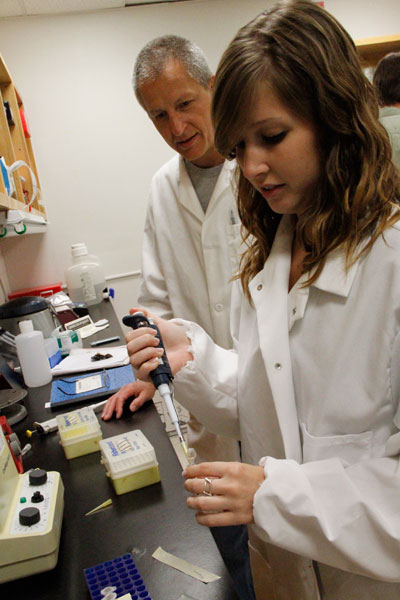Little-Known Protein May Be Key To Fighting Two Diseases
NewsAlex Sharp VIII ('10), JMU Public Affairs

More information about Malaria
More information about Leishmaniasis
The Researchers:
Chris Lantz
Ken Roth
A protein that may have a role in combating a serious parasitic skin infection that threatens American soldiers serving in the Middle East may also have a role in fighting another world-wide menace: malaria.
Dr. Chris Lantz, an associate professor of biology at James Madison University, hopes his research will shed light on just what role interleukin-3—or IL-3—can have in remedying both scourges.
Lantz had no intention of researching the affects of IL-3 on malaria when he started looking into how the little-known protein affects cutaneous leishmaniasis, a tropical skin disease afflicting more than 10 million people in 82 mostly developing countries. But some unexpected test results in his parasitology class broadened the scope of his IL-3 investigation. Students in the class discovered that genetically modified mice that were deficient in IL-3 became more ill with malaria than normal mice.
"The animals that were deficient in IL-3 were more severely anemic, their spleen was twice as enlarged as the normal mice, and they ended up having more red blood cells infected with malaria," Lantz said. That result indicated the IL-3 protein was pivotal in combating the malaria infection.
"Most research labs would probably have only tackled one of these diseases, because it's enough work to do just one," said Lantz, the director of both the malaria and the leishmaniasis research. "But since we've got such exciting data on both, we're moving forward with both."
Dr. Ken Roth, a visiting assistant professor of biology at JMU and Lantz's former classmate at the Medical College of Virginia in the 1980's, helps oversee the malaria research in the lab, allowing Lantz to focus more on leishmaniasis.
Roth and junior biology major Lauren Howe are gathering initial data from both types of mice, those deficient in IL-3 and normal mice, before beginning malaria experiments. They record body temperatures and weights and collect blood to compare pre- and post-infection data.
Once the experiments begin, "we'll look at the blood plasma to see if IL-3 induces any changes in the levels of various secreted signaling proteins called cytokines, just to see if they respond differently," Roth said. "We want to look and see if one or the other becomes more severely infected. Cytokines are thought to be involved in regulating the immune response to infection."
Roth said this stage in the project is just basic science and that he and Howe are working on one piece of a large puzzle in the fight against malaria.
"If we can learn what this one protein does, that's one piece of that big puzzle," Roth said. "And there are other people working on other pieces of the puzzle. So somebody real smart some day is going to put the whole puzzle together and say ‘Ahh! We know what we can do about this now."
"We're trying to learn, what is it that interleukin-3 does when this mouse gets malaria," he said, adding that since malaria primarily kills infants and small children, a treatment developed for that population would be very beneficial. "And ultimately, what I would like is to see some sort of therapy that could be developed for humans who have malaria. But that's way down the road."
Bryan Saunders, a graduate student working with Lantz on the cutaneous leishmaniasis research, said the body produces the IL-3 protein in response to infection, but no one knows all of its functions.
One way he is testing IL-3 is by studying mice—some normal and some deficient in IL-3—to see if there is any difference in how they respond to the leishmania infection.
Cutaneous leishmaniasis is a debilitating skin disease transmitted to humans by sand fly bites. A small parasite is transmitted to the host and replicates "like crazy," Saunders said. The infection causes "big nasty lesions that leave wicked scars," he said.
The majority of cases of leishmaniasis occur in Afghanistan, Peru, Saudi Arabia and Syria, which have sand flies as well as mosquitoes that transmit malaria.
"In the United States there's a really big increase in the interest in this disease because of the war over there," Saunders said. "Soldiers are coming back with cutaneous leishmaniasis and going to physicians who have never seen this disease. How would they know what to diagnose?"
Lantz is collaborating with research giant SRI International, which recently opened an office in Rockingham County and was temporarily housed in Burruss Hall. He has received nearly $60,000 in grants from the Jeffress Memorial Trust since 2005 to continue the research. And since realizing the surprising parallels between malaria and leishmaniasis, that money is used for both projects.
"Right now, we know that if a person or an animal is missing this protein, that in one disease, leishmaniasis, it appears that IL-3 is making it worse." Lantz said. "It's the opposite result in malaria: if you have IL-3, it's making it better. And so therapeautically speaking, if it turns out that this one protein can influence the course of the disease, then you're looking at treatments either designed to inhibit the production of IL-3, or enhance the production of IL-3, depending on which disease you have."
"It's a pretty good system we have going on here," Lantz said, adding that over the summer he will be applying for a $300,000 grant from the National Institute of Health that will fund research in both diseases. "All of the students we have are working on both projects interchangeably, because some experiments are so big that everybody ends up helping each other with things."

